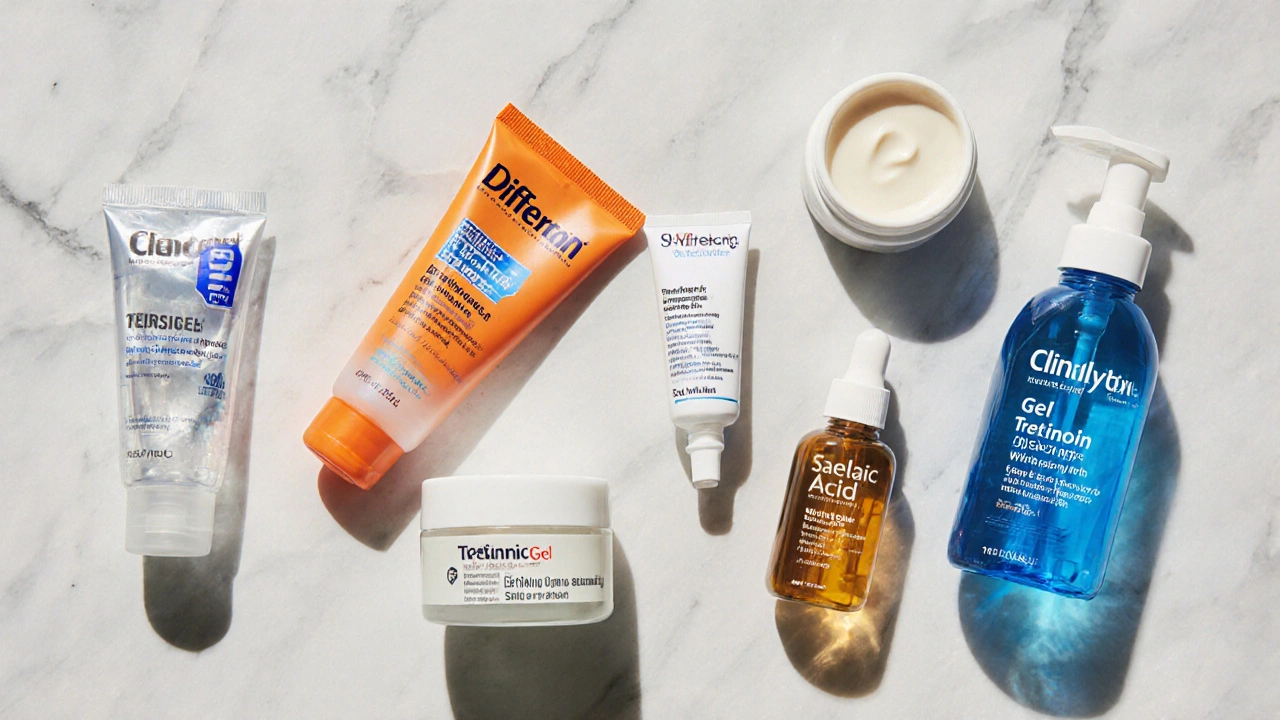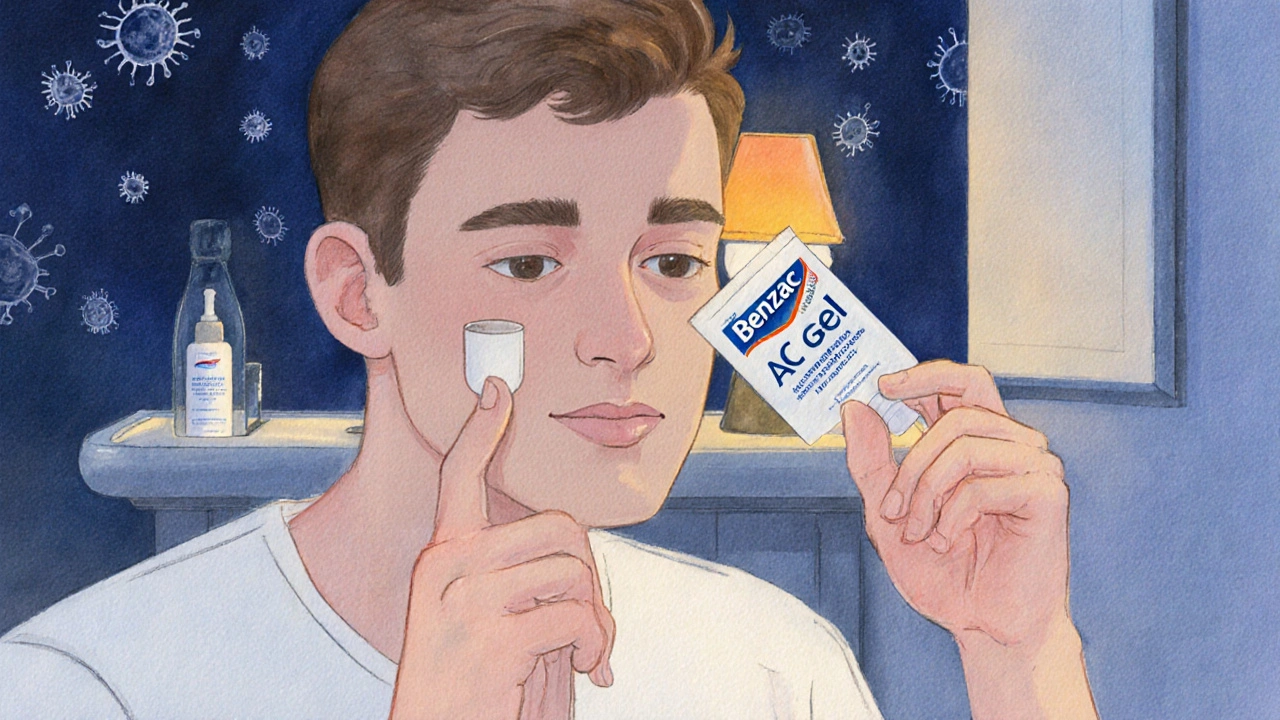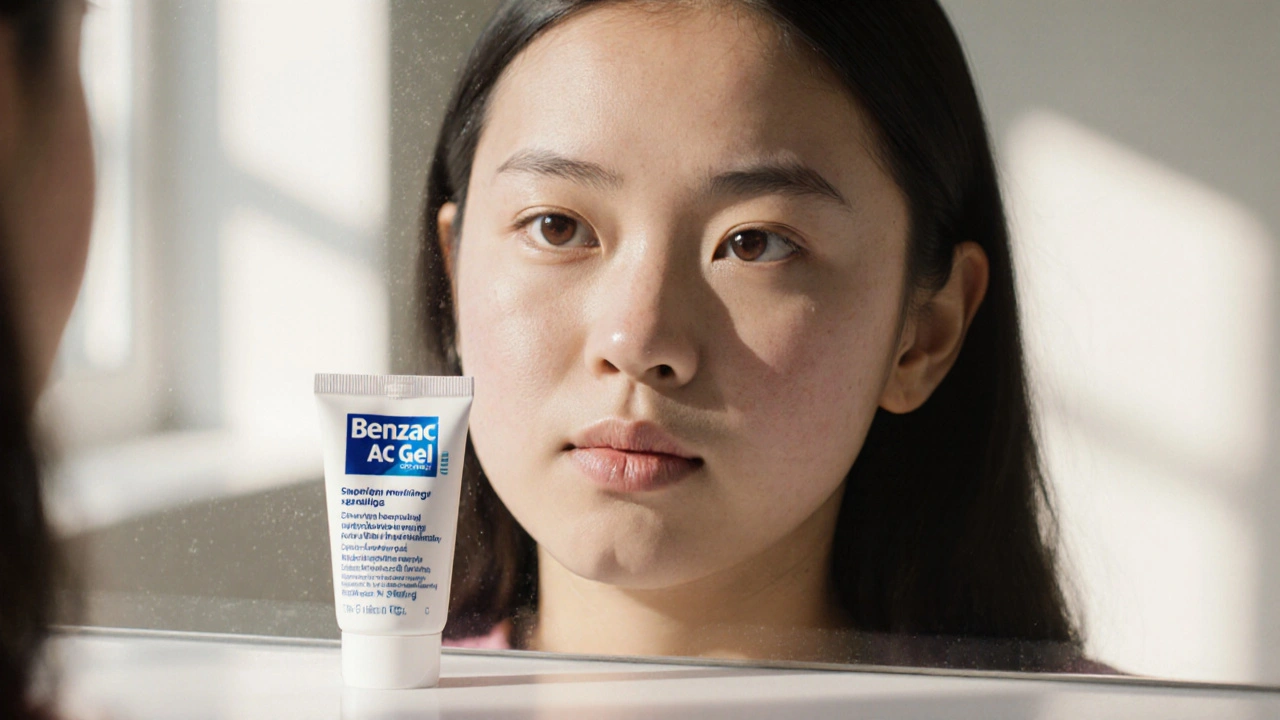Acne Treatment Selector
Recommended Treatment
Why This Works For You
Treatment Comparison Table
| Product | Active Ingredient | Strength | Primary Benefit | Irritation Level | Cost (USD) |
|---|---|---|---|---|---|
| Benzac AC Gel | Benzoyl Peroxide | 5% | Fast bacterial kill, reduces oil | Medium-High | $12-$15 |
| Differin Gel | Adapalene | 0.1% | Clears pores, limits new lesions | Low-Medium | $20-$25 |
| Clindamycin Phosphate Gel | Clindamycin | 1% | Reduces inflammation, combats bacteria | Low | $30-$35 |
| Tretinoin Cream | Tretinoin | 0.025% | Prevents future breakouts, improves texture | Medium-High | $25-$40 |
| Salicylic Acid Cleanser | Salicylic Acid | 2% | Exfoliates inside pores, unclogs blackheads | Low | $8-$12 |
| Azelaic Acid Gel | Azelaic Acid | 15% | Antibacterial, reduces redness, evens tone | Low-Medium | $30-$45 |
| Niacinamide Serum | Niacinamide | 5% | Barrier repair, soothe irritation | Very Low | $15-$20 |
Acne can feel like a never‑ending battle, especially when you’re not sure which product actually clears the skin without leaving a red trail. Benzac AC Gel is one of the most talked‑about over‑the‑counter options, but dozens of other gels, creams, and serums promise the same result. This guide lines up Benzac AC Gel side by side with the most common alternatives so you can decide which one fits your skin, budget, and lifestyle.
Key Takeaways
- Benzac AC Gel uses 5% benzoyl peroxide, delivering fast bacterial kill but can irritate sensitive skin.
- Adapalene (Differin) offers similar efficacy with less dryness, ideal for breakout‑prone teens.
- Clindamycin gels add antibacterial power without the peeling effect, best for inflamed pimples.
- Retinoids like tretinoin work slower but improve texture and prevent future lesions.
- Gentler acids (salicylic, azelaic, niacinamide) suit sensitive skin or combination regimens.
What Is Benzac AC Gel?
Benzac AC Gel is a topical acne medication that contains 5% benzoyl peroxide as its active ingredient. The gel’s lightweight texture spreads easily, dries to a matte finish, and works by oxidizing the cell walls of Propionibacterium acnes (now called Cutibacterium acnes) while also shedding the top layer of dead skin cells.
Key attributes:
- Concentration: 5% benzoyl peroxide
- Form: Clear gel, 30g tube
- Typical price (USD, 2025): $12‑$15
- Frequency: Once daily, preferably at night
Because the peroxide is powerful, users often experience a tingling sensation, mild redness, or peeling during the first two weeks. The side‑effects usually fade as the skin builds tolerance.
Popular Alternatives to Benzac AC Gel
Below are the eight most frequently compared acne products. Each description includes the first microdata markup to help search engines recognize the entity.
Differin Gel is a 0.1% adapalene gel that belongs to the retinoid family, targeting inflammation and clogged pores without the harsh dryness of older retinoids.
Clindamycin Phosphate Gel is a prescription‑strength 1% antibiotic gel that reduces bacterial load and inflammation, often used in combination with benzoyl peroxide.
Tretinoin Cream is a vitamin A derivative applied at 0.025% concentration, promoting cell turnover and preventing new comedones.
Salicylic Acid Cleanser is a 2% beta‑hydroxy acid wash that exfoliates inside hair follicles, helping to clear blackheads and whiteheads.
Azelaic Acid Gel is a 15% prescription gel that kills acne‑causing bacteria and reduces redness, while also brightening post‑inflammatory hyperpigmentation.
Niacinamide Serum is a 5% form of vitamin B3 that calms inflammation, strengthens the skin barrier, and works well alongside other actives.
These alternatives span three main categories: retinoids (Differin, Tretinoin), antibiotics (Clindamycin), and acids/ingredients that focus on exfoliation and barrier support (Salicylic, Azelaic, Niacinamide). Each has a distinct mode of action, cost profile, and irritation potential.

Side‑by‑Side Comparison
| Product | Active Ingredient | Typical Strength | Primary Benefit | Irritation Level | Cost (USD, 2025) | Best For |
|---|---|---|---|---|---|---|
| Benzac AC Gel | Benzoyl Peroxide | 5% | Fast bacterial kill, reduces oil | Medium‑High | $12‑$15 | Moderate‑to‑severe inflammatory acne |
| Differin Gel | Adapalene | 0.1% | Clears pores, limits new lesions | Low‑Medium | $20‑$25 | Teenagers, sensitive newcomers to retinoids |
| Clindamycin Phosphate Gel | Clindamycin | 1% | Reduces inflammation, combats bacteria | Low | $30‑$35 (prescription) | Inflamed papules, combination therapy |
| Tretinoin Cream | Tretinoin | 0.025% | Prevents future breakouts, improves texture | Medium‑High | $25‑$40 (prescription) | Adult acne, post‑acne scarring |
| Salicylic Acid Cleanser | Salicylic Acid | 2% | Exfoliates inside pores, unclogs blackheads | Low | $8‑$12 | Combination‑type skin, occasional breakouts |
| Azelaic Acid Gel | Azelaic Acid | 15% | Antibacterial, reduces redness, evens tone | Low‑Medium | $30‑$45 (prescription) | Rosacea‑prone acne, hyperpigmentation |
| Niacinamide Serum | Niacinamide | 5% | Barrier repair, soothe irritation | Very Low | $15‑$20 | Sensitive skin, layered regimens |
How to Choose the Right Product for You
Think of the decision like building a pizza: the crust is your skin type, the sauce is your primary concern (oil, inflammation, post‑acne marks), and the toppings are secondary goals (smooth texture, minimal irritation). Use this quick checklist:
- Identify your acne type. If you see red, painful pustules, you need a strong antibacterial like benzoyl peroxide or clindamycin. For blackheads and mild breakouts, a BHA (salicylic) or adapalene works well.
- Assess sensitivity. Sensitive skin should start with low‑irritation options (niacinamide, azelaic, low‑dose adapalene).
- Set a budget. Over‑the‑counter gels (Benzac, Differin) are cheaper than prescription antibiotics or tretinoin.
- Consider long‑term goals. If you want to prevent future scars, a retinoid or azelaic acid adds collagen‑boosting benefits.
- Plan a layering strategy. If you combine actives, keep the most irritating one (e.g., benzoyl peroxide) on alternate nights.
Most dermatologists recommend starting with a single active for four weeks, then gradually introducing a second if you tolerate it well.
Using Benzac AC Gel Safely
- Cleanse with a gentle, sulfate‑free cleanser. Pat skin dry.
- Apply a pea‑sized amount to the affected area only. The gel is potent; more isn’t better.
- Leave it on overnight. Do not rinse off the next morning.
- If you notice excessive dryness, follow with a lightweight, non‑comedogenic moisturizer after the gel has absorbed (about 15 minutes).
- Limit sun exposure. Benzoyl peroxide can make you more photosensitive, so use at least SPF30 during the day.
- Schedule a break after 8-12 weeks if irritation persists. Many users switch to a maintenance regimen with a milder active like niacinamide.
Common pitfalls include applying too thick a layer, using on broken skin, and mixing with other strong acids in the same night, which spikes irritation.

Real‑World Scenarios
Scenario 1 - Teen with Hormonal Acne: A 15‑year‑old with inflamed papules on the forehead finds Benzac AC Gel clears lesions within two weeks but experiences peeling. Switching to Differin Gel on alternate nights and using a hyaluronic‑acid moisturizer keeps the skin calm while still targeting breakouts.
Scenario 2 - Adult with Sensitive, Combination Skin: A 32‑year‑old sees mild redness with benzoyl peroxide. A regimen starting with a low‑dose azelaic acid gel in the morning, niacinamide serum at night, and occasional spot treatment with clindamycin works without flare‑ups.
Scenario 3 - Post‑Acne Hyperpigmentation: After clearing an outbreak with Benzac AC Gel, the user adds a 15% azelaic acid gel in the evening and continues sunscreen diligently. Within three months, dark spots fade noticeably.
Frequently Asked Questions
Frequently Asked Questions
Can I use Benzac AC Gel and Differin together?
It’s possible but not recommended for beginners. Both actives can cause irritation; most dermatologists suggest alternating nights-Benzac in the evening, Differin on the opposite night-so your skin can recover.
How long does it take to see results with Benzac AC Gel?
Visible reduction in red bumps usually appears after 5‑7 days of consistent use. Full clearance of moderate acne can take 3‑4 weeks.
Is Benzac AC Gel safe for pregnant women?
Benzoyl peroxide is classified as Category C, meaning risk cannot be ruled out. Pregnant women should consult their OB‑GYN before using any topical acne medication.
What should I do if my skin becomes overly dry?
Cut back to every‑other‑day application, add a ceramide‑rich moisturizer, and avoid other exfoliants for a week. Hydration restores the barrier and reduces peeling.
Can I switch from Benzac AC Gel to a prescription antibiotic?
Yes. Many dermatologists start with benzoyl peroxide, then add clindamycin or erythromycin if lesions persist. Always follow a doctor’s guidance to avoid antibiotic resistance.
Choosing the right acne treatment is personal, but comparing key attributes-strength, irritation, cost, and long‑term benefits-makes the decision a lot less guesswork. Whether you stick with Benzac AC Gel or move to a gentler acid, consistency and proper skin care habits are the real winning moves.


Jill Brock
October 7, 2025 AT 15:01Listen up, because the truth about Benzac AC Gel is buried under a mountain of hype that the beauty industry loves to peddle like cheap candy. First, the 5% benzoyl peroxide concentration is a double‑edged sword that can annihilate the bacteria but also turn your face into a battlefield of redness and peeling that most people mistake for “working”. Second, the claim that it’s the ultimate solution for moderate to severe acne ignores the fact that the irritation level is classified as medium‑high, which means a significant portion of users will experience burning, dryness, and occasional flaking that can last weeks. Third, when you compare the cost–effectiveness ratio, you’ll find that for the same price you could get a retinoid or a prescription antibiotic that offers comparable results with fewer side effects. Fourth, the marketing fails to mention that benzoyl peroxide can bleach fabrics, so you might end up with pink shirts and discolored pillowcases. Fifth, the product’s gel base, while light, can feel sticky and may clog pores if over‑applied, which is the exact opposite of what you need for acne‑prone skin. Sixth, users often misuse it by applying a thick layer, thinking more is better, but that only magnifies the irritation. Seventh, the recommendation to use it nightly without a proper moisturizer neglects the skin barrier repair that is crucial after such a harsh active. Eighth, studies show that starting with a lower concentration (2.5%) can be just as effective for many, minimizing the harshness. Ninth, the article’s checklist is a decent guide, but it glosses over the fact that combining benzoyl peroxide with other acids in the same routine is a recipe for disaster. Tenth, the suggested “alternate night” approach is sensible, yet many users ignore it and push through the pain, only to end up with worse inflammation. Eleventh, the guidance on sunscreen is vital because benzoyl peroxide can increase photosensitivity, but not everyone adheres to it, leading to hyperpigmentation. Twelfth, the long‑term effects of continuous high‑strength peroxide use are still not fully understood, raising concerns for chronic skin barrier compromise. Thirteenth, the article’s tone feels like it’s trying to sell the product rather than presenting unbiased data. Fourteenth, the emotional rollercoaster described by users – excitement at early clearing followed by dismay at flaking – is a pattern that suggests the product isn’t for the faint‑hearted. Fifteenth, if you’re looking for a sustainable, gentle approach, you might be better off with a combination of niacinamide, azelaic acid, and consistent sun protection, reserving Benzac AC Gel for short, targeted bursts when a flare really needs taming.
Ellie Chung
October 8, 2025 AT 10:28Whoa, Jill’s fiery rant kinda hits the nail on the head, but let’s not forget that Benzac AC Gel can actually be a hero for those stubborn, inflamed pimples that refuse to budge. It’s like a fireworks show on your face-in a good way-when you see those zits shrink overnight. Just remember to start slow, and maybe throw in a soothing moisturizer so you don’t look like a tomato.
Sophia Simone
October 9, 2025 AT 05:55While others celebrate the convenience of over‑the‑counter options, I must point out that the comparative analysis presented in the article lacks rigorous statistical backing. The efficacy metrics for benzoyl peroxide versus adapalene are drawn from disparate study populations, rendering the juxtaposition somewhat misleading. Moreover, the cost assessment fails to incorporate insurance coverage scenarios that could drastically alter the perceived value proposition of prescription‑strength alternatives.
Juan Sarmiento
October 10, 2025 AT 01:21Hey there, Sophia! Totally get where you’re coming from-data matters. For anyone on a budget, starting with a low‑dose benzoyl peroxide and adding a gentle moisturizer can give solid results without the prescription hassle. Remember to patch test and give your skin time to adapt; consistency is the real game‑changer.
Patrick McVicker
October 10, 2025 AT 20:48Yo, Benzac AC Gel does the job but it can be a bit harsh if you’re not careful. I’d say start with a pea‑size amount, let it dry, then slap on a light moisturizer. 👍
Liliana Phera
October 11, 2025 AT 16:15Patrick, your blunt advice hits the spot, yet we must consider the philosophical underpinnings of skin health: the skin is not merely a canvas for chemical warfare, but a living organ seeking balance. To wage war with benzoyl peroxide without the balm of empathy-i.e., a soothing moisturizer-creates a discordant symphony that ultimately harms the self. Therefore, I implore you to pair aggression with compassion, lest we become victims of our own ruthless pursuit of clear skin.
Dean Briggs
October 12, 2025 AT 11:41When evaluating acne treatment options, one must contemplate the multifaceted nature of dermatological therapeutics, recognizing that the path to clear skin is not a linear trajectory but rather an intricate tapestry woven from varying pharmacologic mechanisms, patient adherence patterns, and the psychosocial impacts of visible lesions. Initiating therapy with a low‑concentration benzoyl peroxide, such as 2.5%, may confer sufficient antibacterial activity while mitigating epidermal disruption; however, for individuals exhibiting pronounced inflammatory lesions, escalation to a 5% formulation like Benzac AC Gel can be justified, provided that a concurrent barrier‑supporting regimen-incorporating niacinamide or ceramide‑rich moisturizers-is employed to offset transepidermal water loss and mitigate erythema. Moreover, the temporal window for observable improvement typically spans five to seven days for inflammatory lesion reduction, yet full lesion clearance may necessitate a twelve‑week horizon, underscoring the importance of patient education regarding realistic expectations. The incorporation of adjunctive agents, such as topical retinoids, must be judiciously timed to avoid synergistic irritation; a staggered approach-in which benzoyl peroxide is applied on alternate evenings and retinoids on the intervening nights-has been demonstrated to preserve therapeutic efficacy while preserving cutaneous tolerance. Finally, adherence to photoprotection remains paramount, as both benzoyl peroxide and retinoids sensitize the epidermis to ultraviolet radiation, thereby necessitating daily application of broad‑spectrum sunscreen with at least SPF 30. In summation, the optimal acne management algorithm is predicated upon a personalized balance of antimicrobial potency, anti‑inflammatory capacity, barrier support, and patient compliance, each calibrated to the individual's dermatologic phenotype and lifestyle considerations.
Sadie Speid
October 13, 2025 AT 07:08Dean, wow that was a marathon of knowledge! TL;DR: start low, moisturize, don’t overdo it, and protect with SPF. You’ve got this!
Sue Ross
October 14, 2025 AT 02:35The article does a solid job laying out the basics, but a quick tip: if you’re using Benzac AC Gel, apply it only to active spots, not your entire face. This reduces unnecessary irritation and helps preserve the skin barrier.
Rohinii Pradhan
October 14, 2025 AT 22:01Sue, while your advice is practical, it neglects the crucial point that benzoyl peroxide has a well‑documented propensity to oxidize and degrade certain skin‑care actives, such as vitamin C serums, rendering them ineffective if layered incorrectly. A disciplined routine must account for these chemical incompatibilities.
Anna-Lisa Hagley
October 15, 2025 AT 17:28I find the data presented quite compelling, yet the article could better emphasize the importance of a gradual introduction to minimize adverse reactions. A thoughtful, stepwise approach often yields superior outcomes.
A Walton Smith
October 16, 2025 AT 12:55Agree, start slow.
Theunis Oliphant
October 17, 2025 AT 08:21While the prose attempts to appear inclusive, it subtly perpetuates a consumerist mindset, urging readers to purchase yet another 'must‑have' product without adequately addressing the socioeconomic constraints many face. A more balanced discourse would acknowledge affordable alternatives and the dignity of frugal stewardship.
India Digerida Para Occidente
October 18, 2025 AT 03:48Theunis, you raise valid concerns about accessibility. In practice, many find that a simple regimen of gentle cleansing, targeted benzoyl peroxide for flare‑ups, and consistent sunscreen can be both effective and budget‑friendly.
Andrew Stevenson
October 18, 2025 AT 23:15From a clinical perspective, the key takeaway is the synergy between antibacterial action and barrier repair. Benzoyl peroxide offers rapid lesion reduction, but coupling it with a ceramide‑rich moisturizer can prevent transepidermal water loss and mitigate erythema, ultimately enhancing patient adherence and long‑term success.
Kate Taylor
October 19, 2025 AT 18:41Andrew, truly spot‑on. I’d add that selecting a non‑comedogenic moisturizer with niacinamide boosts the anti‑inflammatory response, creating a well‑rounded protocol for those prone to both acne and barrier dysfunction.
Hannah Mae
October 20, 2025 AT 14:08Honestly, Benzac is overrated; just keep a good cleanser and you’ll be fine.
Iván Cañas
October 21, 2025 AT 09:35Even though simple cleansers are great, many people with persistent inflammatory acne benefit from the antimicrobial potency of benzoyl peroxide, especially when used responsibly with moisturization.
Jen Basay
October 22, 2025 AT 05:01Great rundown! 😊 Remember to patch test any new product before full‑face application.
Hannah M
October 23, 2025 AT 00:28👍 Got it! Thanks for the reminder! 🧴✨